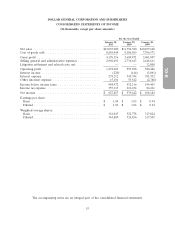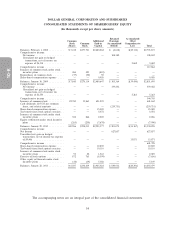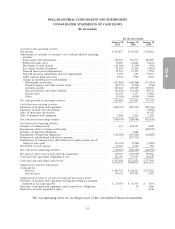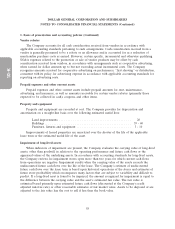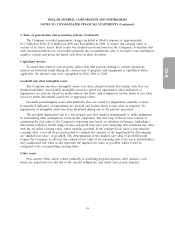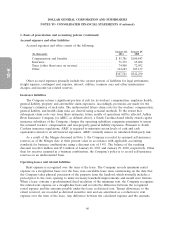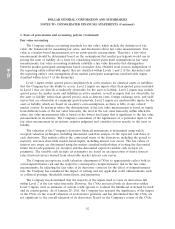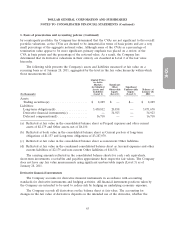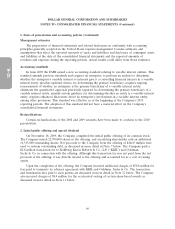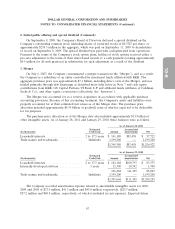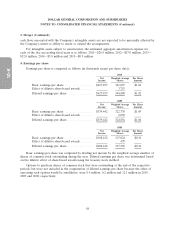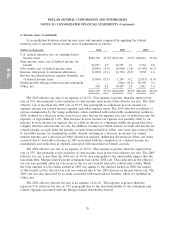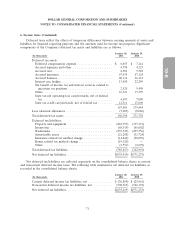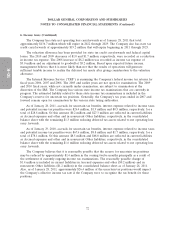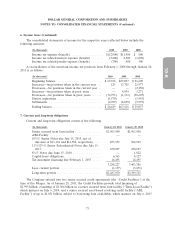Dollar General 2010 Annual Report Download - page 141
Download and view the complete annual report
Please find page 141 of the 2010 Dollar General annual report below. You can navigate through the pages in the report by either clicking on the pages listed below, or by using the keyword search tool below to find specific information within the annual report.
10-K
DOLLAR GENERAL CORPORATION AND SUBSIDIARIES
NOTES TO CONSOLIDATED FINANCIAL STATEMENTS (Continued)
1. Basis of presentation and accounting policies (Continued)
by counterparty portfolio, the Company has determined that the CVAs are not significant to the overall
portfolio valuations, as the CVAs are deemed to be immaterial in terms of basis points and are a very
small percentage of the aggregate notional value. Although some of the CVAs as a percentage of
termination value appear to be more significant, primary emphasis was placed on a review of the
CVA in basis points and the percentage of the notional value. As a result, the Company has
determined that its derivative valuations in their entirety are classified in Level 2 of the fair value
hierarchy.
The following table presents the Company’s assets and liabilities measured at fair value on a
recurring basis as of January 28, 2011, aggregated by the level in the fair value hierarchy within which
those measurements fall.
Quoted Prices
in Active
Markets Significant
for Identical Other Significant
Assets and Observable Unobservable Balance at
Liabilities Inputs Inputs January 28,
(In thousands) (Level 1) (Level 2) (Level 3) 2011
Assets:
Trading securities(a) ..................... $ 8,289 $ — $— $ 8,289
Liabilities:
Long-term obligations(b) .................. 3,450,812 20,858 — 3,471,670
Derivative financial instruments(c) ........... — 34,923 — 34,923
Deferred compensation(d) ................. 16,710 — — 16,710
(a) Reflected at fair value in the consolidated balance sheet as Prepaid expenses and other current
assets of $2,179 and Other assets, net of $6,110.
(b) Reflected at book value in the consolidated balance sheet as Current portion of long-term
obligations of $1,157 and Long-term obligations of $3,287,070.
(c) Reflected at fair value in the consolidated balance sheet as noncurrent Other liabilities.
(d) Reflected at fair value in the condensed consolidated balance sheet as Accrued expenses and other
current liabilities of $2,179 and non-current Other liabilities of $14,531.
The carrying amounts reflected in the consolidated balance sheets for cash, cash equivalents,
short-term investments, receivables and payables approximate their respective fair values. The Company
does not have any fair value measurements using significant unobservable inputs (Level 3) as of
January 28, 2011.
Derivative financial instruments
The Company accounts for derivative financial instruments in accordance with accounting
standards for derivative instruments and hedging activities. All financial instrument positions taken by
the Company are intended to be used to reduce risk by hedging an underlying economic exposure.
The Company records all derivatives on the balance sheet at fair value. The accounting for
changes in the fair value of derivatives depends on the intended use of the derivative, whether the
63


